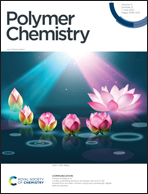Activation of different C–F bonds in fluoropolymers for Cu(0)-mediated single electron transfer radical polymerization†
Abstract
The activation of C–F bonds is an interesting and challenging topic in organic synthetic chemistry and has drawn significant attention in the past few years. We report the grafting of poly(methyl methacrylate) (PMMA) using different poly(vinylidene fluoride) (PVDF)-based fluoropolymers via single electron transfer controlled radical polymerization (SET-CRP). In this process, C–F bonds were directly activated by Cu(0)/2,2′-bipyridine (Bpy) under moderate conditions, in which a Cu(0) rather than a Cu(I) complex was used as the catalyst and exhibited a high activation rate without halogen exchange. The content of the grafted PMMA is 17.1 mol%, while the initiation of TrFE units is 59.1 mol% for c-P(VDF-TrFE) (poly(vinylidene fluoride-trifluoroethylene)). The grafting reaction can be successfully initiated from different types of C–F bonds, and the C–F bonds of CFH in c-P(VDF-TrFE) have been verified to be the most active C–F species due to the decreased β-H elimination and the suitable electron-donating environment of c-P(VDF-TrFE). This can be confirmed by comparing the activation rates, BDE data, and electrochemical behavior of C–F bonds in different chemical environments.



 Please wait while we load your content...
Please wait while we load your content...